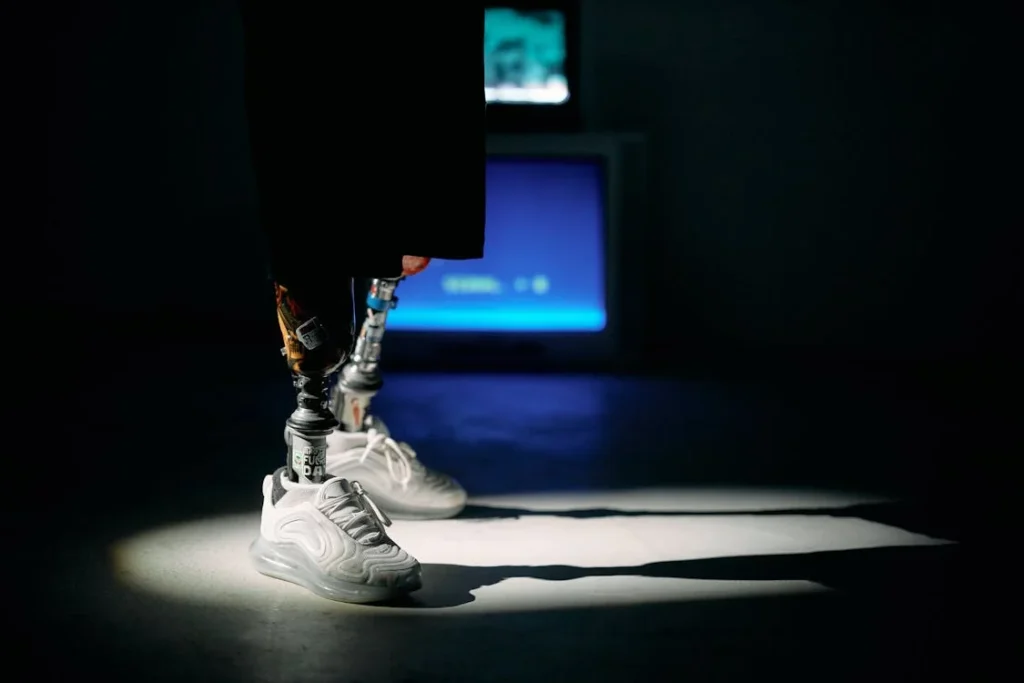Losing both limbs, whether hands or legs, changes every part of a person’s life. Moving, holding things, walking, balancing — tasks that once felt natural now demand much more thought and effort. For bilateral amputees, daily life becomes a constant challenge of learning new ways to do the simplest things.
At Robobionics, we have spent years understanding these needs, not just from a technical side but from a human side too. We believe that real help comes when you truly understand the small struggles, the hidden hurdles, and the real dreams of those who live with limb loss every day.
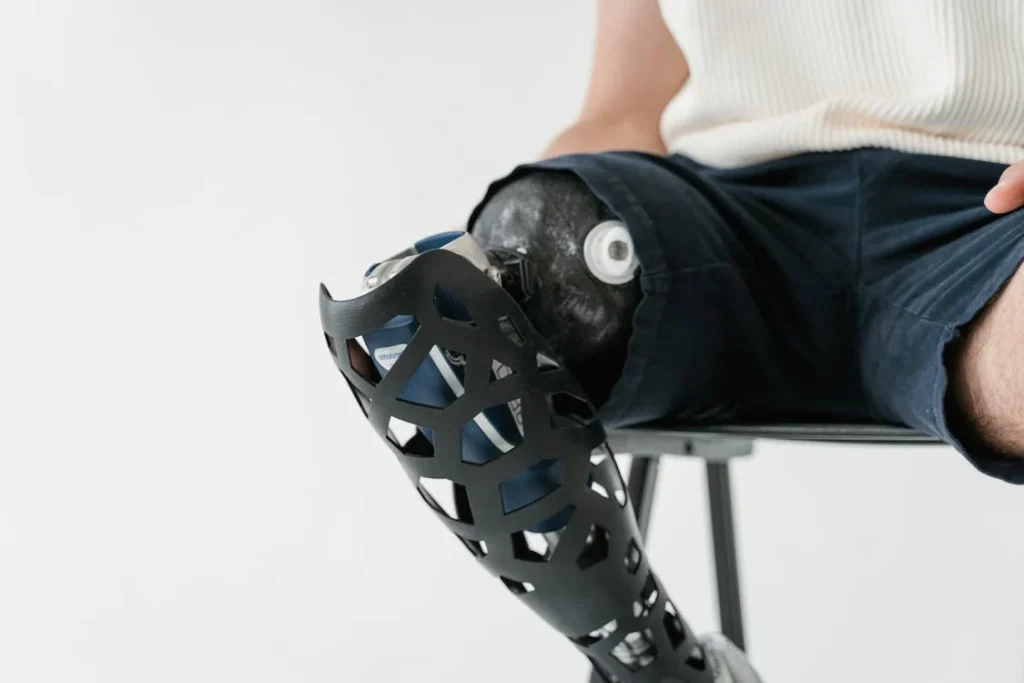
How Bilateral Limb Loss Changes the Body’s Mechanics
When someone loses both arms or both legs, the body doesn’t just lose the ability to move in the usual ways. It starts to change deeply from the inside.
Muscles, bones, joints, and even the way the brain controls the body start to shift. The body is always trying to find new balance and new ways to do things.
Balance and Stability
For people with bilateral leg amputations, balance becomes one of the biggest challenges. The legs are not just for walking; they are the pillars that hold the body upright.
Without them, the center of gravity changes completely. Instead of relying on the strength of the legs and feet, the body now depends heavily on the trunk, hips, and even the arms if they are present.
Sitting, standing, and transferring from a wheelchair all require new skills and muscles that most people never think about.
For those with bilateral arm amputations, stability issues also arise, but in different ways. Arms help the body maintain posture and shift weight smoothly.
Without them, simple tasks like leaning forward or sideways become harder because the body lacks the counterbalance that arms naturally provide.
Energy Consumption
Walking with two prosthetic legs, or handling tasks without natural arms, demands much more energy. Studies have shown that bilateral lower limb amputees often burn twice as much energy as non-amputees when walking the same distance.
The body has to work harder because it uses different muscles and often in ways they were not meant to be used all the time.
This higher energy cost affects daily living. Activities that used to seem simple — shopping, visiting friends, even getting around the house — can feel like climbing a hill.
Understanding this is important because it shows why prosthetic design must focus on being as light, efficient, and supportive as possible.
Joint and Muscle Strain
Without natural limbs, other parts of the body take on the extra load. For bilateral leg amputees, the lower back and hips bear far more stress.
Over time, this can lead to back pain, hip joint problems, and muscle fatigue. For bilateral arm amputees, the shoulders, neck, and spine often suffer from strain.
This is why a good rehabilitation program does not just focus on learning to use prosthetics. It must also strengthen the muscles that support the body in new ways and prevent long-term injury.
Brain and Nervous System Changes
The brain is amazing in its ability to adapt. After losing both arms or legs, the brain begins to rewire itself. Areas that used to control the missing limbs start to change, often taking on new tasks.
This plasticity is powerful, but it also means that early training and therapy are crucial. Without guidance, the brain might settle into unhealthy patterns that make future movement harder.
Prosthetic training must tap into this brain flexibility, encouraging good habits and building new “movement maps” inside the mind.
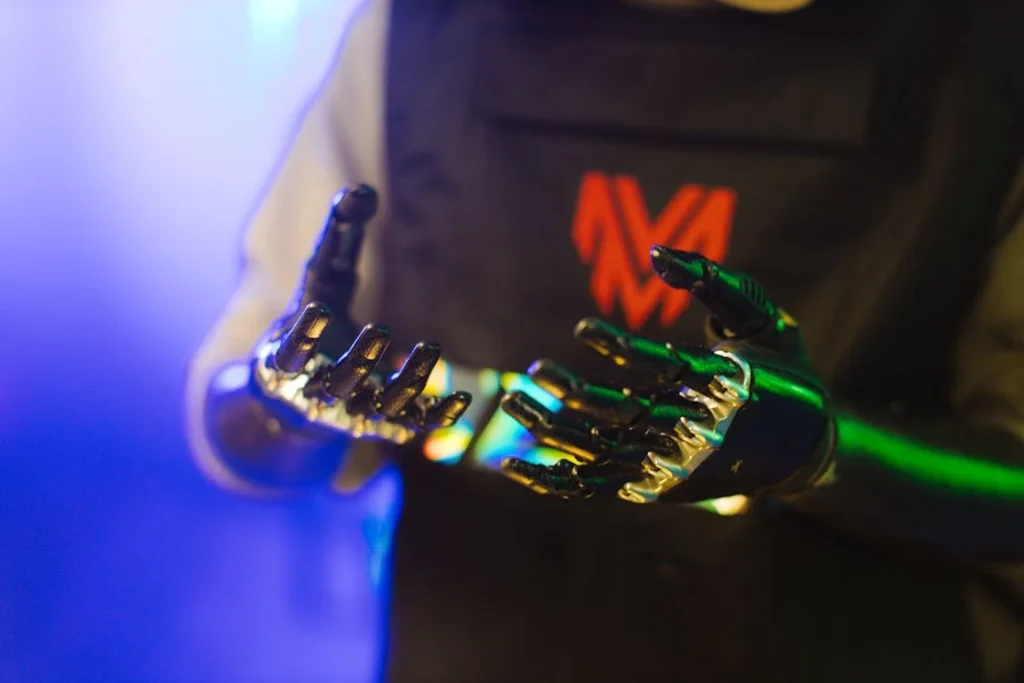
Key Biomechanical Needs Specific to Bilateral Upper Limb Amputees
Losing both arms brings a different set of challenges than losing legs. Arms are not just for grabbing things; they help with balance, gestures, communication, and even simple daily tasks like dressing or eating.
When both arms are missing, the body and mind must adapt to a new way of living. Understanding these changes deeply helps create prosthetic solutions that make life easier and more natural.
Need for Fine Motor Control
One of the biggest needs for bilateral upper limb amputees is fine motor control. It’s not just about picking up a cup or holding a book. It’s about doing it gently, without crushing or dropping it.
Everyday tasks like buttoning a shirt, using a phone, or tying shoelaces require a delicate and controlled touch.
Prosthetic hands must offer not just strength but the ability to move fingers independently and adjust grip pressure.
Sensors that detect how hard or soft a person wants to grip something are vital. Without this, users often feel disconnected from their movements, leading to frustration and even accidents.
Need for Speed and Reaction
Speed matters more than we think. Imagine trying to catch a falling object or moving your hand quickly out of harm’s way.
Bilateral upper limb amputees need prosthetics that can respond fast, almost like a natural arm. Delays in prosthetic movement can make everyday tasks tiring or unsafe.
Quick, smooth reactions in a prosthetic hand or arm require powerful yet lightweight motors, smart software, and designs that mimic how real muscles work.
The goal is to allow the user to react naturally, without having to think deeply about every movement.
Need for Shoulder and Torso Compensation
Without arms, the body naturally tries to use the shoulders and torso more. People twist, bend, and shift their weight in unusual ways to make up for the missing limbs. Over time, this can cause back pain, shoulder injuries, and neck strain.
Prosthetic solutions must support the body’s natural posture as much as possible. Designs that are too heavy or awkward will make these problems worse.
A well-designed prosthetic arm should work with the body’s movement, not against it, keeping the user’s posture balanced and healthy.
Need for Emotional Connection
Beyond physical needs, there is a powerful emotional side. Hands are part of how we express ourselves. Waving hello, shaking hands, clapping, pointing — all of these small gestures matter.
Bilateral upper limb amputees often talk about feeling invisible or disconnected when they cannot express themselves through natural gestures.
Prosthetic designs that allow for simple, human gestures — even if it’s just an open hand movement or a light touch — play a huge role in emotional well-being. It’s not just about functionality; it’s about dignity and connection.
Need for Easy Learning
Learning to use two prosthetic arms at once is a steep challenge. Each movement involves more steps, more thought, and more effort.
Prosthetic systems must be simple to understand and easy to control. Complicated systems that demand too much mental effort will often get abandoned because users feel overwhelmed.
Training should focus on small, achievable milestones. Building muscle memory over time helps movements feel natural, not forced.
This is why intuitive controls, like sensors that pick up muscle signals, make a big difference. They allow users to think less about how they are moving and more about what they want to do.
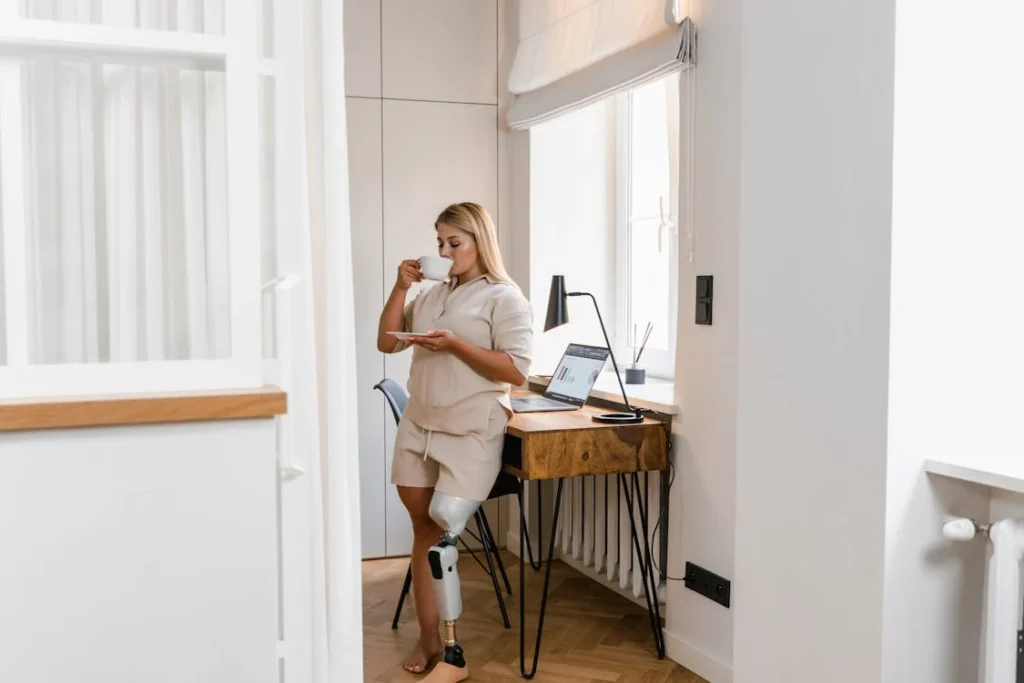
Key Biomechanical Needs Specific to Bilateral Lower Limb Amputees
When someone loses both legs, the challenges they face are not only about walking again. Every simple thing — standing, balancing, sitting, and moving from one place to another — becomes a bigger task.
The body has to learn all over again how to stay upright and move safely. Understanding these needs is essential to create prosthetics that feel like a real part of the body.
Need for Stable Standing and Walking
Standing is one of the biggest milestones for a bilateral lower limb amputee. Without real legs, the body’s natural sense of balance is shaken. Standing still without falling takes a lot more effort.
Prosthetic legs must offer strong, stable support. They need to lock safely when standing and adjust easily when moving. If the knees of the prosthetics buckle or if the ankles feel loose, the person will always fear falling.
That fear can hold back their confidence to walk freely. A good prosthetic leg must feel like a solid pillar beneath them, giving the body the trust it needs to stand tall again.
Need for Smooth, Natural Walking Motion
Walking on two prosthetic legs should feel as close to natural walking as possible. If the movement feels stiff, robotic, or uneven, it can cause not only discomfort but real long-term damage to the hips, back, and spine.
A smooth walking motion depends on how well the knee and ankle joints in the prosthetic can mimic natural movement. The knee should bend and straighten at just the right times. The ankle should flex and push off softly, not slam against the ground. Good design helps the user walk with a natural rhythm, saving energy and preventing strain.
Need for Controlled Turning and Moving on Uneven Surfaces
Walking in a straight line is one thing. Turning corners, stepping over obstacles, climbing stairs, or walking on uneven ground — these tasks need extra balance and quick adjustments.
Bilateral lower limb amputees need prosthetics that help them turn and adapt quickly without feeling unstable.
Good ankle flexibility and responsive knee control are key here. Without them, every step outside a flat, smooth floor becomes a risk.
Turning should not require big, exaggerated movements. The more natural the turning feels, the more independent the user can be. Even small adjustments, like a slight foot rotation, make a big difference.
Need for Comfortable Sitting and Standing Transfers
Sitting down and standing up again sound simple but are very challenging with two prosthetic legs. The person must manage their body weight, balance the prosthetics correctly, and control the bending of artificial knees all at once.
Prosthetics must support easy bending at the knees and offer steady support as the user lowers themselves or rises up.
The design must reduce the fear of losing balance halfway through the movement. Every successful transfer builds trust and makes the user more confident in daily life.
Need for Light Weight and Energy Efficiency
Carrying two prosthetic legs all day is hard work. Every extra gram adds to the effort needed. Heavy prosthetics tire the user quickly and put stress on the hips and lower back.
Lightweight materials like carbon fiber or special plastics can make a big difference. But it’s not just about weight.
The energy return — how much “spring” the prosthetic foot gives back with each step — also matters a lot. Good energy return reduces the load on the body and makes walking less tiring.
The best prosthetics work like a good partner: strong but light, responsive but supportive.
Need for Safety Against Falls
Falls are one of the biggest fears and dangers for bilateral lower limb amputees. A bad fall can cause serious injuries and slow down recovery for months.
Prosthetics must have safety features built in. This means knees that lock automatically if the user stumbles and feet that grip the ground well.
The user should feel that their prosthetics are helping them stay upright, not something they have to fight to control.
Fall prevention is not just about hardware, though. It’s also about good training. Teaching users how to regain balance quickly and how to recover from small slips can save them from bigger accidents.
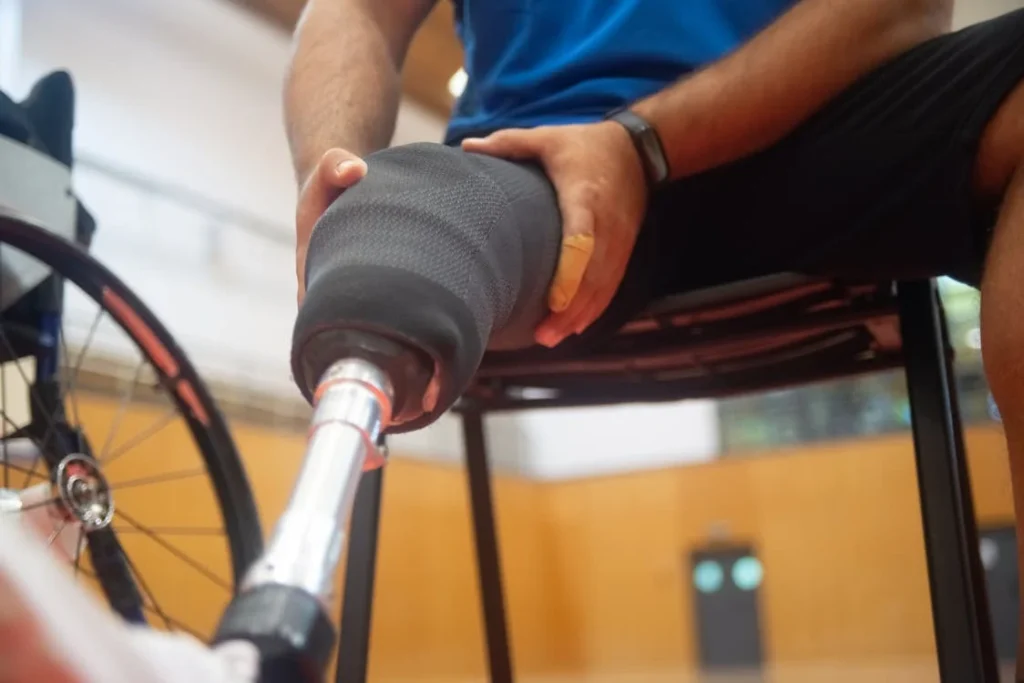
Psychological and Emotional Needs That Impact Biomechanics
When talking about biomechanics, it’s easy to focus only on the body — the joints, the muscles, and the movement. But the mind plays a huge role too.
How a person feels about their body deeply affects how they move. For bilateral amputees, emotional and psychological health can change everything, from balance and walking speed to posture and energy levels.
Need for Confidence in Movement
Confidence is not just a feeling. It’s something you can see in the way a person stands and moves. Someone who feels unsure or afraid of falling will move differently — slower, more rigid, always looking down at their feet or worrying about every step.
This stiffness actually makes falls more likely because the body is not moving naturally. Fear locks up the muscles and delays reactions.
In contrast, someone who feels confident moves smoothly, adapts quickly, and stays more balanced.
That’s why early wins in prosthetic training are so important. Even small successes — taking a few steps, standing up without help — help build the mental strength needed for bigger achievements later.
Need for a Sense of Control
Losing both arms or both legs often makes people feel like they have lost control over their bodies. Prosthetic technology must give that sense of control back.
The user should feel that they are the one deciding every movement, not just reacting to what the prosthetics are doing.
Simple, intuitive control systems are key. If operating a prosthetic is confusing or slow, the user will not feel in charge. They might even stop using it altogether. When the prosthetic feels like an extension of their will, confidence and joy in movement grow naturally.
Need for Hope and Motivation
Rehabilitation after bilateral limb loss is long and often hard. There are days when the user feels stuck, frustrated, or hopeless. Without a strong emotional anchor — a sense of hope and a reason to keep going — it’s easy to give up.
Hope fuels effort. Motivation strengthens the body just as much as exercise does. Good rehabilitation programs support mental health along with physical training.
They celebrate small milestones, listen to frustrations, and remind users that even slow progress is still progress.
Positive emotions even affect biomechanics directly. Studies have shown that people who feel happy or motivated walk faster, have better posture, and use less energy while moving. Emotions are not just feelings; they change how the body works.
Need for Social Interaction
Humans are social creatures. Losing both arms or legs can sometimes make people feel isolated. They may avoid social gatherings because of fear, embarrassment, or physical barriers. But social interaction is not just about happiness. It’s also about movement.
Talking with friends, laughing, gesturing, standing in groups — all these activities train balance, muscle control, and reaction speed.
Prosthetics that allow users to participate easily in social life do more than restore dignity; they strengthen the body in real, measurable ways.
Prosthetic designs should allow users to feel proud and confident in public. The more someone feels comfortable being seen, the more they move, and the stronger and more natural their biomechanics become over time.
Need for Emotional Expression Through Movement
We don’t just move to get from place to place. We move to express ourselves. We wave, we hug, we dance, we throw our hands up in excitement. Without the ability to express emotions through the body, life can feel muted.
Bilateral upper limb amputees especially need prosthetics that allow for gestures, even simple ones like opening a hand or raising an arm. Movement gives emotional freedom. It allows people to show joy, sadness, surprise, and excitement in ways words cannot.
When prosthetic technology supports emotional expression, it gives back a part of life that many don’t even realize they lost until they feel it again.
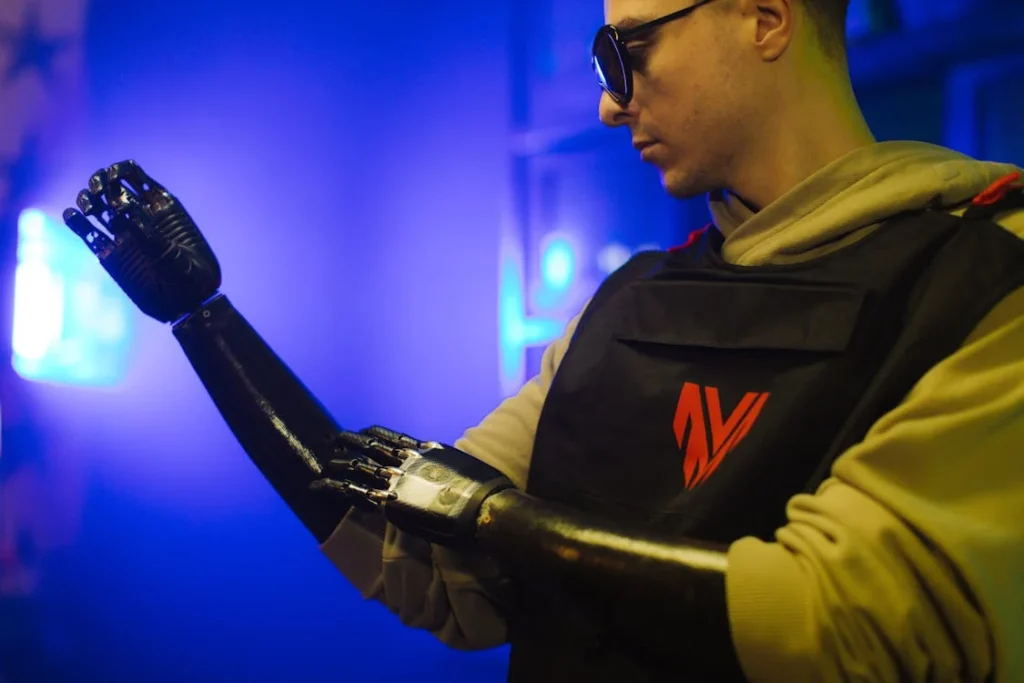
Design Considerations for Prosthetics That Truly Meet Biomechanical Needs
Understanding the needs of bilateral amputees is only the first step. The next challenge is designing prosthetics that truly meet those needs. Good design is not just about technology or fancy features.
It’s about how the prosthetic feels in real life, how it supports the body naturally, and how easily it fits into everyday life.
Comfort Comes First
If a prosthetic is not comfortable, it will not be used, no matter how advanced it is. Comfort starts with a perfect fit. The socket — the part that attaches the prosthetic to the body — must hug the body gently but firmly. It should distribute weight evenly to avoid pressure points that cause pain.
The materials used inside the socket also matter. They should be soft, breathable, and skin-friendly. Sweat and heat build-up can cause irritation, infections, and even wounds. Cooling liners, smart fabrics, and better airflow designs help keep the skin healthy and the user comfortable all day.
Lightweight Without Losing Strength
Every gram matters. A heavy prosthetic drains energy, stresses the body, and slows down movement. However, reducing weight cannot mean making the device weaker. It must still handle daily stresses like walking, lifting, or standing for hours.
Materials like carbon fiber, titanium, and high-strength plastics offer a good balance. They are strong enough to survive rough daily use but light enough to move naturally.
Good engineering finds smart ways to cut weight without cutting strength, sometimes by shaping parts more efficiently or using layered materials.
Responsive, Natural Movement
A prosthetic must move when and how the user wants it to. This is where responsive control systems come in. For upper limbs, this could mean muscle signal sensors that pick up even tiny muscle movements and translate them into hand or arm actions.
For lower limbs, smart knees and ankles adjust their stiffness and angle based on the ground surface and walking speed.
Microprocessors inside these joints can predict the next movement based on the user’s current step, making movement smoother and more natural.
Responsiveness is key to making the user feel connected to the prosthetic rather than feeling like they are battling a machine.
Easy Maintenance and Durability
A prosthetic that breaks easily or demands constant repairs is a source of endless stress. It disrupts daily life and often leaves the user feeling helpless again. Durability must be built into the design from the start.
Joints, motors, and connectors must be tough enough to withstand real-world conditions like rain, dust, drops, and long hours of use.
Maintenance tasks like battery charging, part replacement, or cleaning should be easy enough for the user to do at home without needing special tools or long clinic visits.
This is especially important in places where service centers are not nearby or where getting spare parts can take weeks. A well-designed prosthetic respects the user’s independence and keeps them moving no matter what.
Modular and Adaptable Systems
Every person is different. Even two bilateral amputees will have different needs based on their lifestyle, job, hobbies, or body shape. Good prosthetics must be adaptable.
Modular systems allow users to swap parts based on their activities. For example, a user might have one set of feet for walking indoors and another for hiking outdoors.
Hand attachments could vary from a simple gripping hook for tough work to a lifelike hand for social occasions.
Adaptability makes the prosthetic a real part of life, not just a fixed tool.
Natural Appearance and Personalization
Looks matter, not because of vanity but because of confidence. A prosthetic that looks natural or reflects the user’s personality helps them feel proud, not hidden.
Options like skin-toned covers, tattoos, stylish designs, or even bright colors allow users to choose how they want to be seen. Some prefer a natural look that blends in. Others proudly show off their prosthetic as a symbol of strength.
Personalization should be easy and affordable, not a luxury. It sends a powerful message: this prosthetic is not just a machine; it’s part of who I am.
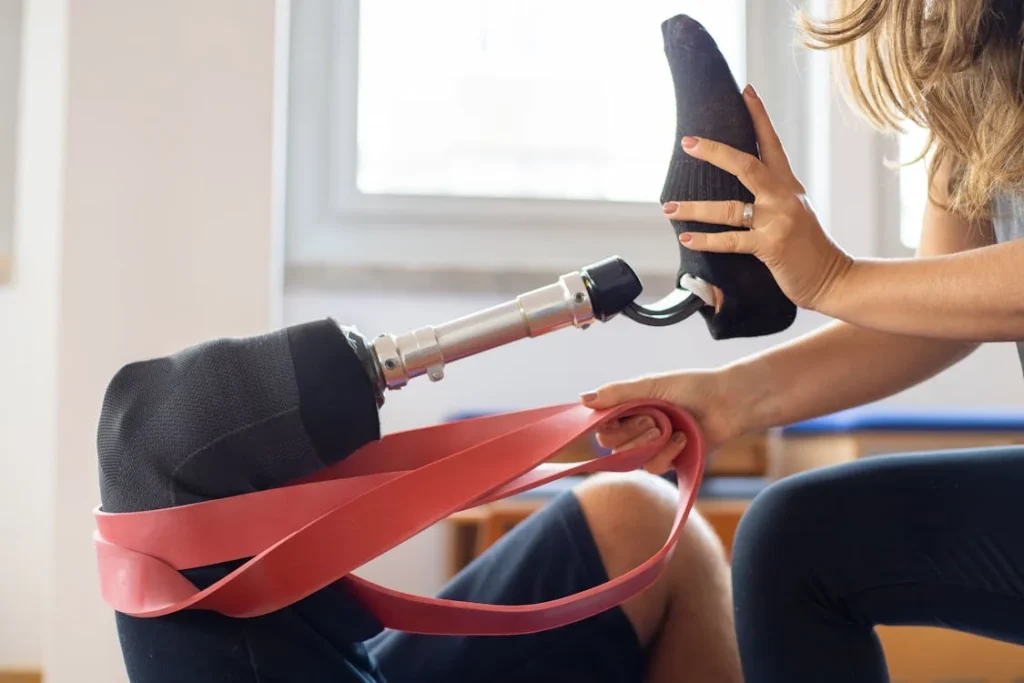
The Role of Rehabilitation in Meeting Biomechanical Needs
Even the best-designed prosthetic cannot fulfill its promise without proper rehabilitation. Rehabilitation is not just about healing wounds or teaching someone how to walk again.
It is about rebuilding a relationship between the mind, the body, and the new prosthetic tools that are now part of life.
For bilateral amputees, rehabilitation must be thorough, thoughtful, and deeply personalized. It is a journey of learning, adapting, and growing stronger in body and spirit.
Early Intervention and Training
The earlier rehabilitation begins, the better the outcomes. Right after amputation, the body and mind are both highly flexible.
The brain is eager to build new pathways, and muscles are ready to adapt. Delaying prosthetic training means the body can fall into bad habits that are harder to fix later.
Early training focuses on preparing the body for prosthetic use. This might include strengthening the core muscles for balance, stretching to keep joints flexible, and working on cardiovascular fitness to handle the extra energy demands of moving with prosthetics.
Early emotional support is just as important. Confidence built during the first few weeks often sets the tone for the entire recovery journey.
Building Muscle Memory
Using a prosthetic should eventually feel natural, like moving a real limb. To get there, the body must build muscle memory — the unconscious ability to move smoothly without thinking about every little step.
This happens through repetitive, structured practice. Simple tasks like standing up, reaching out, or taking a step are repeated over and over until they become second nature.
Muscle memory frees the brain from constantly focusing on movement, allowing the person to focus on life itself — talking to a friend, carrying a bag, or simply enjoying a walk.
Good rehabilitation programs break down complex movements into small steps. Success at each step builds motivation for the next.
Strength and Endurance Training
Moving with two prosthetic legs or handling tasks with two prosthetic arms demands more from the body than natural movement does.
Bilateral amputees must build greater strength and endurance, especially in the muscles that now carry extra workload — the back, hips, shoulders, and core.
Strength training focuses on stabilizing muscles that keep the body upright and balanced. Endurance training builds the stamina needed to handle daily activities without exhaustion.
Without a strong physical foundation, even the best prosthetic can feel like a burden instead of a help.
Gait and Posture Correction
Walking with two prosthetic legs introduces many small but important changes to gait and posture. Even tiny problems in the way a step is taken or how the body leans forward can cause major issues over time — from back pain to joint injuries.
Gait training teaches the user how to move in a way that is safe, efficient, and natural. Therapists watch every detail, from foot placement to hip movement, and guide the user gently toward better habits.
Posture correction ensures that standing, sitting, and moving put the least possible strain on the body. Proper posture also improves breathing, reduces fatigue, and increases confidence.
Functional and Daily Life Training
The goal of rehabilitation is not just movement — it is full, independent living. Functional training focuses on everyday tasks: cooking, getting dressed, using public transportation, or picking up objects from the floor.
Each task is broken down and practiced carefully. New techniques are taught to overcome challenges. For example, a bilateral arm amputee might learn how to use a prosthetic hand to hold clothing steady while dressing, or how to use core strength to open doors smoothly.
The more natural these tasks feel, the more independent and confident the user becomes.
Emotional Support and Counseling
Physical rehabilitation is only half the journey. Emotional support is critical too. Many bilateral amputees go through periods of frustration, sadness, anger, or fear. Counseling helps them process these emotions in a healthy way, keeping motivation strong and preventing feelings of isolation.
Group therapy and peer support programs are especially powerful. Meeting others who are on the same journey provides real inspiration and practical advice. It reminds users that they are not alone — and that success is not just possible but probable with effort and support.
Conclusion
Understanding the biomechanical needs of bilateral amputees goes far beyond technology. It requires seeing the whole person — their body, their mind, and their dreams. True solutions come from designing prosthetics that move naturally, fit comfortably, and support emotional well-being just as much as physical ability.
Rehabilitation plays a crucial role in helping users reconnect with movement and rebuild independence. Every small step forward — every moment of balance, strength, or new confidence — is a powerful victory.
At Robobionics, we believe that innovation must always serve humanity. By listening carefully and designing thoughtfully, we can help bilateral amputees not just move again, but truly live again. The journey is not easy, but with the right support, it leads to strength, dignity, and endless possibilities.



